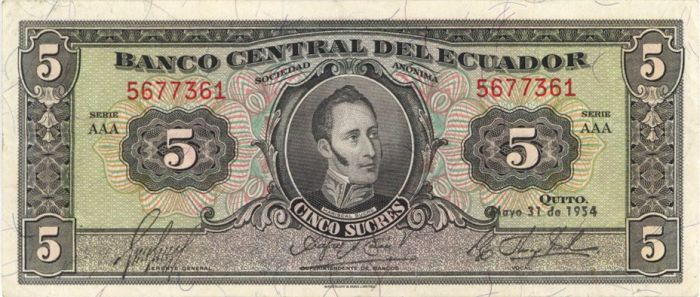Ecuador - P-98c - Ecuadorian Sucre - Foreign Paper Money
Inv# FM2517A Foreign Paper Money
5 Sucres, P-98c.
The Sucre was the currency of Ecuador between 1884 and 2000. Its ISO code was ECS and it was subdivided into 10 Decimos or 100 Centavos. The sucre was named after Latin American political leader Antonio José de Sucre. The currency was replaced by the United States dollar as a result of the 1998–99 financial crisis.
The Ecuadorian peso was renamed as the Sucre on March 22, 1884, and was then linked to the silver standard. The Sucre was tied to 22.5 g of fine silver (equivalent to 5 LMU francs). Outdated coins were taken out of circulation between 1887 and 1892, with only the silver-backed coins remaining in circulation.
The decline of the international price of silver during the 1890s prompted Ecuador to switch to the gold standard on November 3, 1898, with the sucre tied to 732.224 mg of fine gold (equivalent to 2 shillings sterling).
The Sucre became inconvertible shortly after World War I began in 1914 due to international political tension. Despite extensive measures to support the sucre's value, the exchange rate continued to rapidly decline. The sucre's exchange rate was eventually stabilized during 1926, at which point Ecuador re-established the gold standard with the sucre equal to 300.933 mg fine gold or $0.20 USD (a devaluation of 58.8%).
Following the suspension of the gold standard on February 8, 1932, foreign exchange controls were adopted on April 30 which fixed the official buying rate at 5.95 per U.S. dollar. Once the price of silver rose above the nominal value of most silver coins during 1930s, Ecuador banned the export of silver on May 17, 1935. This was followed by several adjustments to the nation’s foreign exchange system as the sucre continued to depreciate. The foreign exchange controls were finally lifted in September, 1937 and the official rate was set at 13.5 sucre per U.S. dollar. The sucre was eventually devalued to 14.77 sucre per USD on June 4, 1940 and controls were once again imposed. The official rate became 14 sucre per USD in 1942 and 13.5 per USD in 1944.
The International Monetary Fund (IMF) established the purchasing power parity of the sucre at 13.5 per USD on December 18, 1946. When the IMF adopted a system of multiple exchange rates in 1947, the sucre's IMF parity was devalued to 15 sucre per USD by 1950, 18 by 1961, and 25 per USD by 1970.
The Sucre maintained a fairly stable exchange rate against the U.S. dollar until 1983 when it was devalued to 42 per USD and a crawling peg was adopted. Depreciation increased rapidly and the Sucre’s free market rate was over 800 per USD by 1990 and nearly 3000 by 1995. The sucre lost 67% of its foreign exchange value during 1999; its value nosedived an additional 17% over the course of one week, ending at 25,000 sucre per USD on January 7, 2000.
On January 9, President Jamil Mahuad announced that the US dollar was to be adopted as Ecuador's official currency, although the US dollar had already had wide informal use in Ecuador before this decision was made. The US dollar became legal tender in Ecuador on March 13, 2000, as sucre notes ceased to be legal tender on September 11, 2000. Sucre notes were exchangeable at a rate of 25,000 sucre per dollar at Banco Central until March 30, 2001.










Ebay ID: labarre_galleries